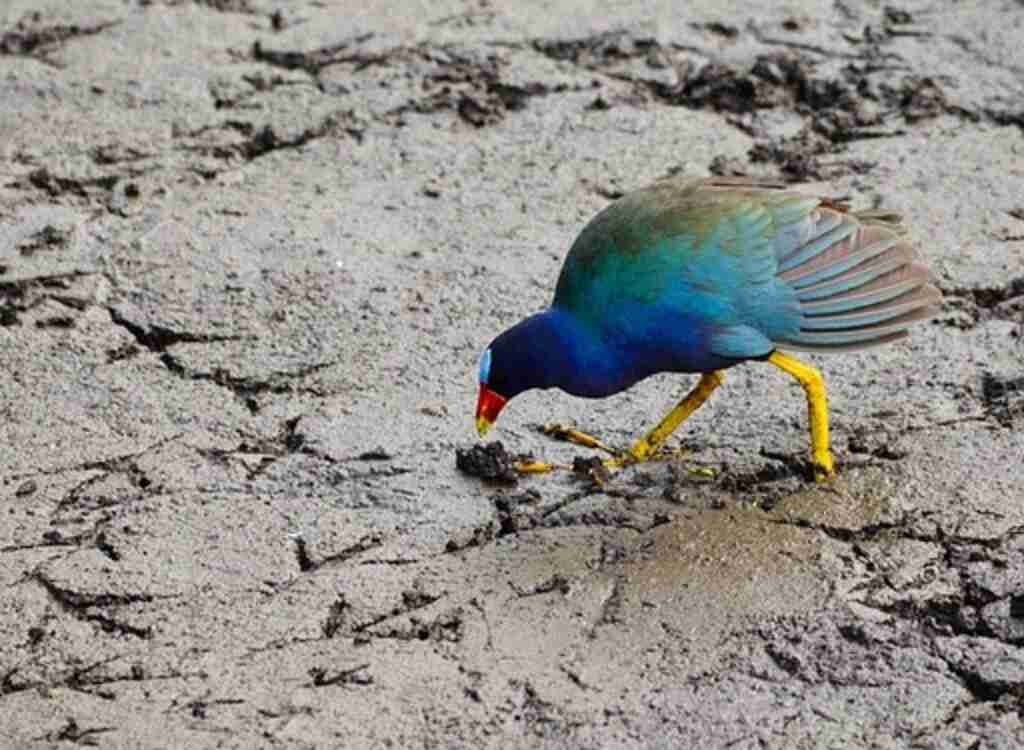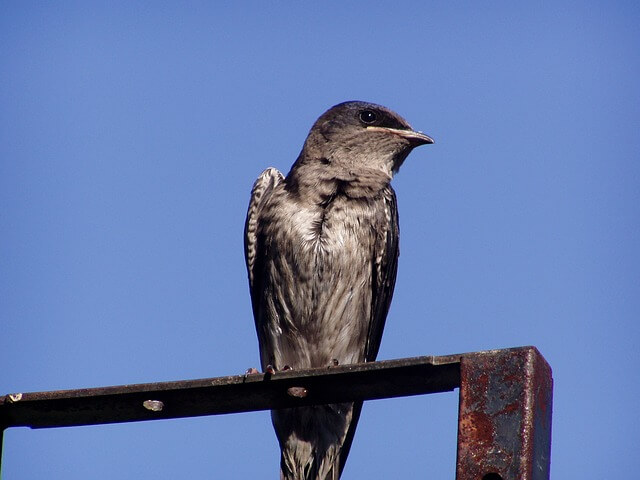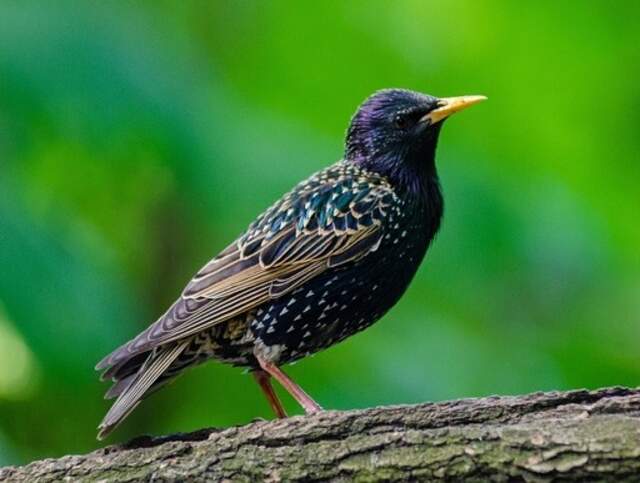North America is home to a diverse range of bird species, many of which are known for their beautiful and striking plumage. Among these are the birds with purple feathers, which stand out with their vibrant colors and unique patterns. From the Great-tailed Grackle to the elusive Purple Finch, there are many species of birds with purple feathers that can be found across North America.
In this article, we will explore 12 of the most common birds with purple feathers in North America, their characteristics, distribution, and interesting facts about each species. Prepare to be astonished by the exquisite beauty and remarkable diversity of these breathtaking birds!
Table of Contents
- 1 Why Do Some Birds Have Purple Feathers?
- 2 Types of Birds With Purple Feathers
- 3 Conclusion
- 4 Author
Why Do Some Birds Have Purple Feathers?
Some bird species have striking purple feathers that catch the eye. But why do they have these colorful feathers? It turns out that the pigment responsible for purple feathers is called structural coloration, which is created through the reflection, scattering, and interference of light by the feather’s structure.
Structural coloration is different from pigments that create colors like red, yellow, and blue. Rather than absorbing and reflecting certain wavelengths of light, structural coloration involves microscopic structures that reflect and refract light to create the appearance of color.
In terms of function, purple feathers can serve a variety of purposes. For some bird species, such as the Purple Martin, males with brighter purple feathers are more attractive to females during the breeding season.
In other cases, purple feathers can serve as a form of camouflage in certain environments, such as in the case of the Purple Finch, which blends in with purple flowers. Additionally, some birds, like the Violet-backed Starling, use their vibrant purple feathers as a signal of dominance to other members of their species.
Types of Birds With Purple Feathers
Purple Finch
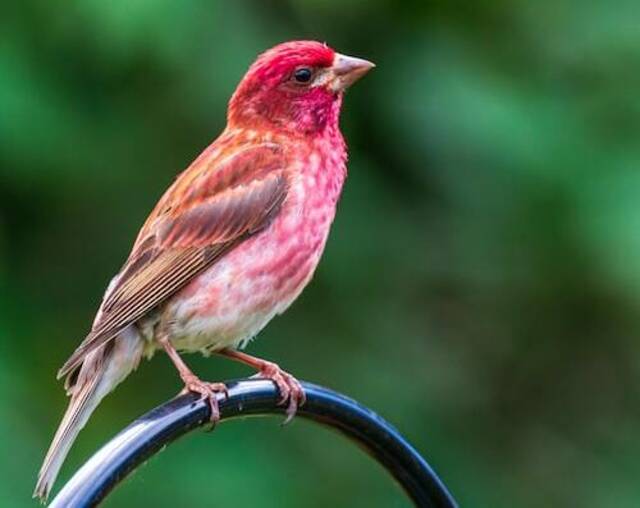
- Scientific Name: Haemorhous purpureus
- Length: 4.7-6.3 in (12-16 cm)
- Weight: 0.6-1.1 oz (18-32 g)
- Wingspan: 8.7-10.2 in (22-26 cm)
- Lifespan (Wild): 3-7 years of age
Identification
The Purple Finch is a medium-sized bird, about 6 inches in length. The male has a bright reddish-purple plumage on its head, breast, and back, while the female has a brownish plumage with heavy streaking on the underparts.
Characteristics
In addition to its distinctive plumage, the Purple Finch has a conical bill that is thick and powerful, which is adapted for cracking open seeds. The wings are short and rounded, and the tail is slightly notched.
Distribution Range
The Purple Finch is found across North America, from southern Canada to Mexico. It breeds in coniferous and mixed forests in the northern parts of its range, and it may move southward during the winter.
Habitat
The Purple Finch prefers coniferous and mixed forests, but it can also be found in open woodlands, suburban areas, and gardens. It is generally a resident bird in the northern parts of its range, but it may migrate southward during the winter.
Diet
The Purple Finch feeds mainly on seeds, including those of conifers, deciduous trees, and weeds. It may also eat some insects during the breeding season.
Purpose of Purple Feathers
The bright reddish-purple plumage of the male Purple Finch serves as a visual signal to attract females during the breeding season. The coloration is produced by pigments called carotenoids, which are obtained from the bird’s diet. The intensity of the coloration may reflect the quality of the bird’s diet and overall health.
Purple Martin
- Scientific Name: Progne subis
- Length: 7.5-7.9 in (19-20 cm)
- Weight: 1.6-2.1 oz (45-60 g)
- Wingspan: 15.3-16.1 in (39-41 cm)
- Lifespan (Wild): 4-14 years of age
Identification
The Purple Martin is a large, dark swallow with a deep, rich purple-blue plumage on its head, back, wings, and tail. The adult male has a more iridescent appearance than the female, which has a duller plumage with gray underparts.
Characteristics
The Purple Martin is the largest North American swallow, measuring around 7 to 8 inches in length with a wingspan of about 15 inches. Its wings are long and pointed, and its bill is short and broad. This bird is a strong flier and can often be seen performing acrobatic aerial displays in flight.
Distribution Range
The Purple Martin breeds in the eastern and central parts of North America, from Canada to Mexico. During the non-breeding season, it migrates to South America, where it spends the winter.
Habitat
The Purple Martin prefers open areas near water, such as wetlands, lakes, and rivers. It often nests in man-made structures such as birdhouses or gourds, and will sometimes form large colonies with other Purple Martins.
Diet
The Purple Martin feeds on a variety of insects, which it catches in flight. It is particularly fond of dragonflies, damselflies, and other flying insects that it can catch on the wing.
Purpose of Purple Feathers
The Purple Martin’s purple feathers serve several purposes. They help to attract a mate during the breeding season, as well as to deter predators by making the bird appear larger and more intimidating. Additionally, the iridescent quality of the feathers helps to reflect sunlight, making the bird more visible in flight.
Violet-green Swallow
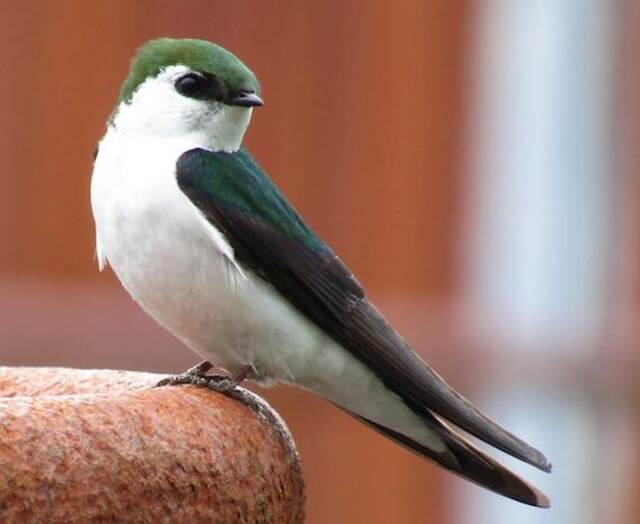
- Scientific Name: Tachycineta thalassina
- Length: 4.7 in (12 cm)
- Weight: 0.5 oz (14 g)
- Wingspan: 10.6 in (27 cm)
- Lifespan (Wild): 6-9 years of age
Identification
The Violet-green Swallow is a small, sleek bird with glossy greenish-blue upperparts and a white underbelly. It has a distinctive violet, purple rump patch and white patches on its wings.
Characteristics
These swallows are highly agile and acrobatic flyers, often seen darting and swooping through the air to catch insects. They have a short, slightly forked tail and a small, pointed bill.
Distribution Range
The Violet-green Swallow is found throughout western North America, from southern Alaska down to Mexico.
Habitat
These swallows prefer open woodlands, meadows, and riparian areas, often near water sources like rivers and ponds. They are also commonly seen in urban areas, nesting on buildings and bridges.
Diet
Violet-green Swallows feed on a variety of flying insects, including flies, mosquitoes, and beetles. They catch their prey in flight, often performing impressive aerial maneuvers to do so.
Purpose of Purple Feathers
The purple rump patch on the Violet-green Swallow is thought to serve as a signal to other swallows during flight, helping to coordinate their movements and maintain flock cohesion. It may also play a role in mate selection and courtship displays.
Black-chinned Hummingbird
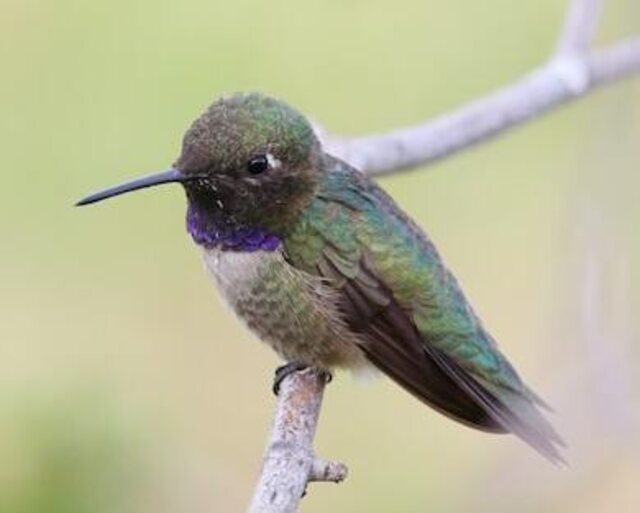
- Scientific Name: Archilochus alexandri
- Length: 3.5 in (9 cm)
- Weight: 0.1-0.2 oz (2.3-4.9 g)
- Wingspan: 4.3 in (11 cm)
- Lifespan (Wild): 8-11 years of age
Identification
The Black-chinned Hummingbird is a small bird, measuring about 3.5 inches in length. The male has a dark green back and a black chin with a purple throat. The female has a green back and a white breast.
Characteristics
This bird has a slender, slightly curved bill that is adapted for probing flowers. They have a high metabolism and must feed frequently, consuming up to twice their body weight in nectar and insects each day.
Distribution Range
The Black-chinned Hummingbird is found in western North America, ranging from southern Canada to Mexico.
Habitat
This bird is typically found in arid and semi-arid habitats, such as deserts, canyons, and foothills. They are also known to inhabit urban areas and gardens with flowering plants.
Diet
The Black-chinned Hummingbird feeds primarily on nectar from flowers, but also consumes insects and spiders for protein.
Purpose of Purple Feathers
The purple feathers on the male’s throat serve a purpose in attracting mates. The bright, iridescent coloration is a visual signal of the male’s fitness and genetic quality, indicating that he is a suitable mate for breeding.
Costa’s Hummingbird
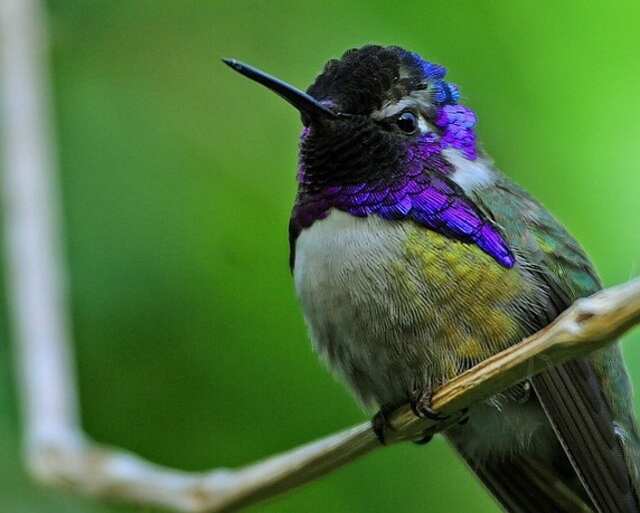
- Scientific Name: Calypte costae
- Length: 3.0-3.5 in. (7.6-9.0 cm)
- Weight: 0.07 – 0.11 oz (2.0-3.0 grams)
- Wingspan: 4.0-4.3 (10.2-11.0 cm)
- Lifespan (Wild): Up to 8 years of age
Identification
A small hummingbird with a straight, thin, and dark bill. Males have a bright purple crown and gorget (throat feathers), and a green back and wings. Females have a grayish-green back and a white breast.
Characteristics
Costa’s Hummingbird has a hovering flight and a high-pitched vocalization. They are also known for their aggressive behavior towards other hummingbirds.
Distribution Range
Costa’s Hummingbird is found in the southwestern United States and Mexico, particularly in desert and scrubland habitats.
Habitat
Costa’s Hummingbird prefers arid habitats such as deserts, thorn forests, and open woodlands.
Diet
Costa’s Hummingbird feeds primarily on nectar from desert flowers and cacti, as well as insects and spiders.
Purpose of Purple Feathers
The bright purple feathers on the male’s crown and throat serve as a display to attract mates and ward off other males from their territory.
Anna’s Hummingbird
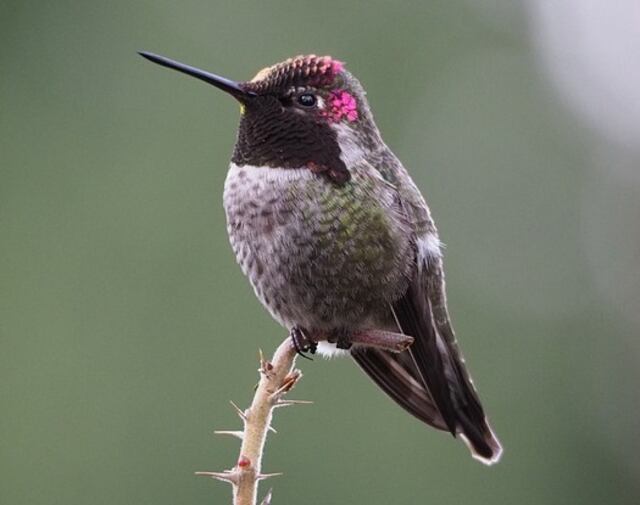
- Scientific Name: Calypte anna
- Length: 3.9 in (10 cm)
- Weight: 0.1-0.2 oz (3-6 g)
- Wingspan: 4.7 in (12 cm)
- Lifespan (Wild): Up to 8.5 years of age
Identification
The male Anna’s Hummingbird has a bright iridescent pinkish-purple throat, head, and crown, with a metallic green back and wings. The female has a more muted greenish-gray plumage, with a white breast and a few scattered iridescent feathers.
Characteristics
Anna’s Hummingbirds are small, measuring only about 4 inches in length and weighing about 1/10 of an ounce. They have a long, thin bill adapted for sipping nectar, and they are able to hover in mid-air to feed from flowers and feeders.
Distribution Range
Anna’s Hummingbirds are found along the western coast of North America, from southern Alaska to Baja California in Mexico. They are also common in urban areas, where they often visit backyard feeders.
Habitat
Anna’s Hummingbirds are adaptable birds and can be found in a variety of habitats, including coastal sage scrub, chaparral, oak woodlands, and urban parks and gardens. They typically prefer areas with a mix of open spaces and trees or shrubs for cover.
Diet
Anna’s Hummingbirds primarily feed on nectar from flowers and sugar water from feeders. They also feed on small insects and spiders for their protein.
Purpose of Purple Feathers
The bright pinkish-purple iridescent feathers on the male Anna’s Hummingbird’s throat and head are used for courtship displays and territorial defense. The feathers reflect light and can appear to change color depending on the angle of the light and the movement of the bird, making them a striking visual display.
Purple Gallinule
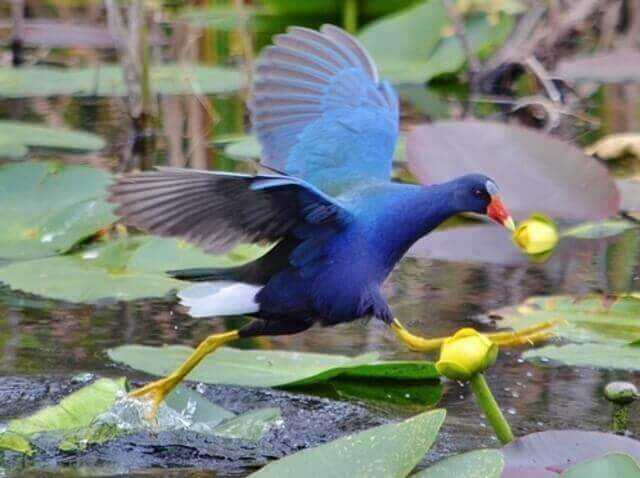
- Scientific Name: Porphyrio martinicus
- Length: 13.0-14.6 in (33-37 cm)
- Weight: 7.2-10.3 oz (203-291 g)
- Wingspan: 21.6-22.1 in (55-56 cm)
- Lifespan (Wild): Up to 7 years of age
Identification
The Purple Gallinule is a medium-sized bird, about the size of a chicken, with a distinctive purple-blue body, green head, and yellow legs. It has a long red bill and a white undertail. Its wings are bright blue with a bold white stripe, visible in flight.
Characteristics
The Purple Gallinule is known for its brightly colored plumage, which is used in courtship displays and to intimidate rivals. It has a loud, distinctive call and is known for its strong swimming abilities, using its long toes to walk on floating vegetation.
Distribution Range
The Purple Gallinule is found in wetland habitats throughout the southeastern United States, as well as in parts of Central and South America. It is a year-round resident in some areas, while in others it is a summer breeding bird or a winter visitor.
Habitat
The Purple Gallinule prefers marshy areas with abundant vegetation, such as swamps, ponds, and wetlands. It is also found in rice fields and other agricultural areas.
Diet
The Purple Gallinule is an omnivore, feeding on a variety of plants and animals. Its diet includes seeds, fruits, insects, snails, and small fish. It forages by walking on floating vegetation and probing with its bill.
Purpose of Purple Feathers
The purpose of the Purple Gallinule’s colorful feathers is not entirely understood, but it is believed that they play a role in courtship displays and territorial behavior. The bright colors may also serve as a form of camouflage in the dense vegetation of wetland habitats.
Rock Pigeon
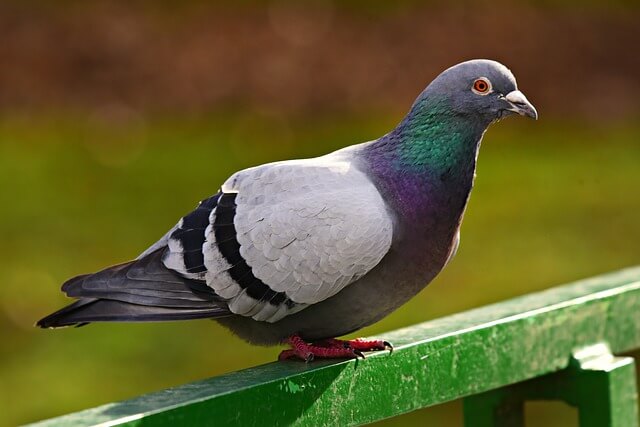
- Scientific Name: Columba livia
- Length: 11.8-14.2 in (30-36 cm)
- Weight: 9.3-13.4 oz (265-380 g)
- Wingspan: 19.7-26.4 in (50-67 cm)
- Lifespan (Wild): 3-6 years of age
Identification
Rock Pigeons have a plump, gray body with two black bands on their wings. They also have a dark, iridescent purple and green neck that shines in the sunlight.
Characteristics
Rock Pigeons are medium-sized birds that can grow up to 13 inches long. They have a short, stout beak and a distinctive strut. They are also known for their cooing call.
Distribution Range
Rock Pigeons are found throughout the world, including in cities and towns in North America, Europe, and Asia.
Habitat
Rock Pigeons are highly adaptable and can live in a variety of habitats, including cities, farms, cliffs, and coastal regions.
Diet
Rock Pigeons have a diverse diet as they consume different kinds of foods such as seeds, grains, insects, and small invertebrates.
Purpose of Purple Feathers
The purpose of the purple feathers on Rock Pigeons is not entirely clear, but it is believed that the iridescence of the feathers may help with mate attraction and communication. The feathers may also play a role in temperature regulation and protection from the sun.
Magnificent Frigatebird
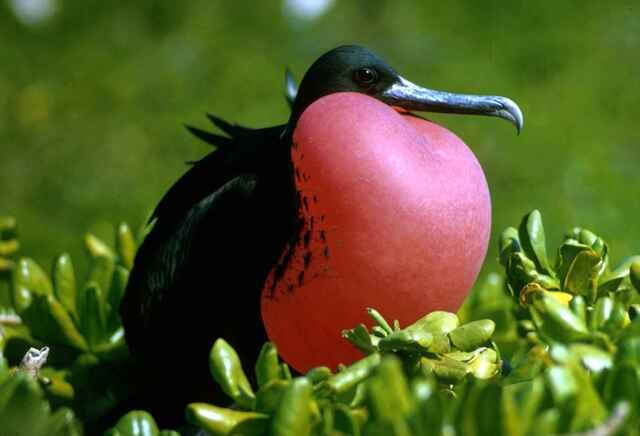
- Scientific Name: Fregata magnificens
- Length: 35.0-44.9 in (89-114 cm)
- Weight: 35.3-67.0 oz (1000-1900 g)
- Wingspan: 85.4-88.2 in (217-224 cm)
- Lifespan (Wild): 14 years of age
Identification
The Magnificent Frigatebird has a black plumage with a purple sheen on its body and wings, with a distinctive red throat pouch that inflates during courtship displays. It has a wingspan of up to 7 feet and a deeply forked tail. The male and female look similar, although the male is slightly larger and has a brighter red throat pouch.
Characteristics
The Magnificent Frigatebird is known for its impressive flying abilities. It can soar for hours without flapping its wings, using thermals to stay aloft. It also has a keen sense of sight, which it uses to locate fish and other prey from high above the ocean.
Distribution Range
The Magnificent Frigatebird is found in tropical and subtropical regions of the Atlantic, Pacific, and Indian Oceans. Its range includes the southern United States, Central and South America, the Caribbean, and various Pacific islands.
Habitat
The Magnificent Frigatebird is a pelagic bird that spends most of its life at sea. It nests in colonies on rocky cliffs or mangrove trees near the coast, but otherwise spends its time soaring over the ocean looking for food.
Diet
The Magnificent Frigatebird feeds on a variety of prey, including fish, squid, and crustaceans. It is known for its ability to steal food from other seabirds, using its agility and speed to snatch prey from their beaks in midair.
Purpose of Purple Feathers
The Magnificent Frigatebird has iridescent purple-black plumage on its body and wings, which appears to change color depending on the lighting conditions. The purpose of this plumage is not entirely clear, but it may play a role in courtship displays, helping to attract mates or intimidate rivals. The purple feathers may also help to camouflage the bird when seen from below against the dark ocean surface.
Great-tailed Grackle

- Scientific Name: Quiscalus mexicanus
- Length: 15.0-18.1 in (38-46 cm)
- Weight: 3.7-6.7 oz (105-190 g)
- Wingspan: 18.9-22.8 in (48-58 cm)
- Lifespan (Wild): Up to 8 years of age
Identification
The Great-tailed Grackle is a large, black bird with a long, keel-shaped tail and a distinctive yellow eye. They have a shiny black plumage with purple iridescence that shimmers in the light. The male Great-tailed Grackle is larger and has a longer tail than the female. They have a distinctive, raucous call that can be heard from a distance.
Characteristics
Great-tailed Grackles are known for their intelligence and adaptability. They are omnivores and have a varied diet that includes insects, fruits, seeds, and small animals. They are also known for their playful behavior and their ability to mimic sounds.
Distribution Range
Great-tailed Grackles are found throughout much of North and Central America, from the southern United States to Panama. They are particularly common in urban areas, where they can be found in parks, gardens, and other open spaces.
Habitat
Great-tailed Grackles prefer open habitats such as grasslands, deserts, and agricultural fields. They are also common in urban areas, where they can be found in parks, gardens, and other open spaces.
Diet
Great-tailed Grackles are omnivorous and have a varied diet that includes insects, fruits, seeds, and small animals. They are opportunistic feeders and will eat whatever is available.
Purpose of Purple Feathers
The purple iridescence of the Great-tailed Grackle’s feathers is thought to play a role in attracting mates. The brighter and more iridescent the feathers, the more attractive the male is to females.
European Starling
- Scientific Name:
- Length:
- Weight:
- Wingspan:
- Lifespan (Wild): Up to 20 years of age
Identification
The European Starling is a small to medium-sized bird that belongs to the family Sturnidae. They have a sleek black plumage with iridescent purple and green sheen, especially during breeding season. It has a short tail, long pointed wings, and a sharp pointed bill.
Characteristics
The European Starling is a highly adaptable bird, known for its excellent singing ability and mimicry skills. It is a social bird that forms large flocks, especially during winter.
Distribution Range
The European Starling is a widespread bird species found across Europe, Asia, and North America. It has been introduced to many other parts of the world, including Australia, New Zealand, and South Africa.
Habitat
The European Starling is a versatile bird that can thrive in a variety of habitats, including urban areas, farmland, and woodland. It prefers open habitats with short vegetation cover and is often found in fields, parks, and gardens.
Diet
The European Starling is an omnivore that feeds on a wide range of food items, including insects, fruits, berries, seeds, and small vertebrates. It often forages on the ground in flocks and is known to cause damage to crops.
Purpose of Purple Feathers
During breeding season, male European Starlings grow iridescent purple feathers on their head, throat, and chest. The purpose of these feathers is to attract mates and establish dominance over other males. The brighter and more iridescent the feathers, the more attractive the male is to females.
Varied Bunting

- Scientific Name: Passerina versicolor
- Length: 4.3-5.5 in (11-14 cm)
- Weight: 0.4-0.5 oz (11-13 g)
- Wingspan: 8.3 in (21 cm)
- Lifespan (Wild): up to 10 years of age
Identification
The Varied Bunting is a small, brightly colored bird with a stocky build. The male has a striking plumage that includes bright blue on the head, back, and wings, with a rusty-red belly and purple on the throat and breast. The female has a more subdued plumage, with olive-green on the head and back, and yellowish-green on the belly.
Characteristics
These birds are known for their distinctive calls, which are a series of high-pitched notes that sound like “chip-chip-chip.” They have a short, stout bill that is adapted for cracking seeds and insects.
Distribution Range
Varied Buntings are found in the southwestern United States and Mexico, including parts of Arizona, New Mexico, Texas, and Mexico.
Habitat
They prefer to live in shrubby habitats, including mesquite brushlands, arid canyons, and desert scrub. They are also found in urban areas with dense vegetation.
Diet
The Varied Bunting feeds mainly on seeds, including those from grasses, weeds, and trees. They also eat insects and occasionally fruits and berries.
Purpose of Purple Feathers
The bright purple feathers on the male Varied Bunting’s throat and breast play an important role in courtship displays. Males will puff out their feathers and sing to attract females during the breeding season. The bright colors and behaviors are a way to demonstrate their fitness and attract a mate.
Conclusion
In conclusion, the birds with purple feathers in North America are a testament to the beauty and diversity of the avian world. From the striking iridescence of the European Starling to the subtle purple hues of the Anna’s Hummingbird, these birds never fail to amaze us with their stunning plumage.
As we continue to appreciate and protect these amazing creatures, let us also remember the importance of preserving their habitats and ensuring their survival for future generations to enjoy.
Related Post: Do All Birds Have Feathers? A Look at the Avian Anatomy!

